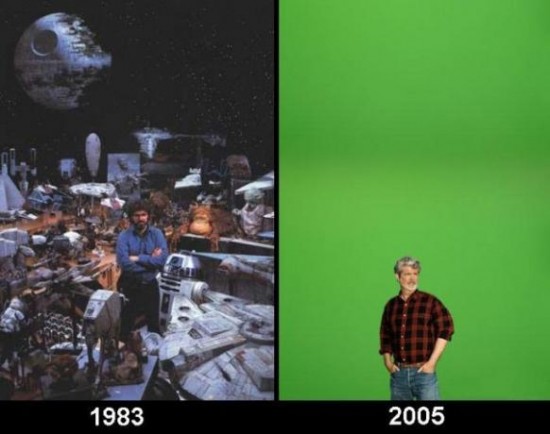Not really asking this from an indy POV here, more of a "guy who doesn't know much about how movies are made to people who do know how movies are made" POV. How does set making work? If they're making a big interior from scratch, do they use scaffolding or what? Is it mostly plywood underneath the pretty surfaces of a sci-fi set? How would you go about making an entire set that looks like it's made of weathered iron or steel? Marble? I suppose there are different methods, depending on whether it's going to be walked on, or just looked at?
You are using an out of date browser. It may not display this or other websites correctly.
You should upgrade or use an alternative browser.
You should upgrade or use an alternative browser.
Set Making
- Thread starter Joe Citizen
- Start date
But large, elaborate sets just LOOK better (in my opinion) and with age, they last.
Theres this wonderful invention called a green screen. They use this to put people in front of CGI backgrounds. And it saves money, too. Set building is almost dead.
..which is everything thats currently wrong with modern mainstream cinema.

Basically.
Last edited:
Not much of an answer to your question so far.
A set built on a soundstage is made from very light material.
Almost all of the walls need to be movable. A lot of foam is used
from hard, carvable foams like polystyrene are used as well as
softer foam. Marble and steel is painted. The set painters and
detailers are amazing craftsmen who can do astounding things to a
piece of luan.
Set building is far, far from being almost dead.
A set built on a soundstage is made from very light material.
Almost all of the walls need to be movable. A lot of foam is used
from hard, carvable foams like polystyrene are used as well as
softer foam. Marble and steel is painted. The set painters and
detailers are amazing craftsmen who can do astounding things to a
piece of luan.
Set building is far, far from being almost dead.
Also, watch LOTR Appedices documentaries (on the extended edition DVD's) for an inspiring look at modern set design.
Yeah, I know CGI's big for sets, but I think it's best for set extension, where realism isn't as important. Shadows and complex lighting are going to look better on real materials than CGI for a long time I think. But yeah I guess that does take a lot of the load off set builders, when you can just build the floor and the lower parts of the walls and CGI the higher stuff.
So, more foam than ply, okay. How does painting something to make it look marble or metal or stone work? Any forums for set painters and detailers?
I'll look at the LotR docs, thanks. Thanks for the replies everyone.
So, more foam than ply, okay. How does painting something to make it look marble or metal or stone work? Any forums for set painters and detailers?
I'll look at the LotR docs, thanks. Thanks for the replies everyone.
When I younger and around the theater environment I used to see some crazy huge sets they would build. All kinds of designers and carpenters and electricians and painters were all over the place, literally hundreds of employees. It was pretty cool.
It’s different than film, but the size and cost of it all is still a mind blow. Each department had its own shop too, like props and costumes and wigs and make up and lighting. I used to walk around and trip out on what everyone was working on, or go into the prop vault and play with all kinds of swords and axes and stuff.
Sometimes they would be driving a truck on stage, other times there would be someone with a horse, it was always surreal.





-Thanks-
It’s different than film, but the size and cost of it all is still a mind blow. Each department had its own shop too, like props and costumes and wigs and make up and lighting. I used to walk around and trip out on what everyone was working on, or go into the prop vault and play with all kinds of swords and axes and stuff.
Sometimes they would be driving a truck on stage, other times there would be someone with a horse, it was always surreal.





-Thanks-
Set building is far, far from being almost dead.
Amen.
The craft is costly, but like Buddy said, it's a whole lot to do.
Amen.
The craft is costly, but like Buddy said, it's a whole lot to do.
These are from David Mullen (While working on Manure):
I always thought they looked cool, and while not cheap, maybe also not super SUPER expensive.



-Thanks-
I always thought they looked cool, and while not cheap, maybe also not super SUPER expensive.



-Thanks-
I think that set building and production design are still massively important cinematic art forms.
Sure green screen works for big scale hollywood blockbusters, but someone still has to build the living room for Mike Leigh's new project.
That even stretches as far as building the interiors of Hogwarts, Hobbiton or The Death Star.
Sure green screen works for big scale hollywood blockbusters, but someone still has to build the living room for Mike Leigh's new project.
That even stretches as far as building the interiors of Hogwarts, Hobbiton or The Death Star.
Most flats (that's what the pieces that make up the walls areSo, more foam than ply, okay. How does painting something to make it look marble or metal or stone work? Any forums for set painters and detailers?
called) are luan and 1x4. For the more permeant and load bearing
walls standard 1/4" plywood is used and almost exactly like
general construction. Painting wood to look like stone or steel is
a learned skill. There are thousands of painters who can do it. It
really isn't any different than a painter painting a picture on
canvas - they paint marble, steel, flowers, fruit and they can
paint a wall made of luan to look like anything.
Theres this wonderful invention called a green screen. They use this to put people in front of CGI backgrounds. And it saves money, too. Set building is almost dead.
Seeing the pictures Buddy provided, you can't possibly see the art as "dead", can you?
These are from David Mullen (While working on Manure):
I always thought they looked cool, and while not cheap, maybe also not super SUPER expensive.
I absolutely love David Mullen's work. I'm not sure if I'm allowed to link to it, but he has some utterly fascinating and very detailed behind-the-scenes stuff on Manure online - if you're a DP or production/set designer it's definitely worth a read. (Lots more nice pictures, too.)
I agree. David Mullen is a top notch. Very knowledgeable, and very generous and patient in sharing that knowledge to help others.
-Thanks-
-Thanks-
CGI is ALWAYS a compromise in my opinion. It's a statement that I either couldn't afford, didn't have the time, couldn't overcome the engineering obstacles, etc.... to create the set, effect, etc... live in the moment, because that's ALWAYS preferable.
That Lucas green screen pic is hilarious.
God that sounds awesome. I'm just imagining how cool it would be to have a "factory" like that at your command, and design a set and sic a bunch of good makers on it. Heaven.
This is turning into a cool thread. Great pics. What's that blue and chrome contraption in foreground right in the third pic from the first series?
They do look cool. I'll have to check Manure out and see how well that background turned out. Is that common, and realistic, or is it kind of a "300" look they're going for?
It's soooo important for "tacky" sci-fi! There are several sci-fi movies I can watch over and over just for the set & wardrobe eye candy: Blade Runner, Alien series, Flash Gordon, Big Trouble in Little China, Judge Dredd, Star Wars, Harry Potter, Underworld, The Fifth Element, Chronicles of Riddick, etc.
Cool. So luan is like light ply, right?
You almost say this like an offhand remark, but that's something I didn't know! It's also good news, as it means what I know about traditional painting, I also know about set painting. Which isn't much, but it's a familiar subject, and I know what's entailed. Is there a dominant medium for "tricky" stuff like weathered metal or stone, say oils, or is it all situation and preference dependent? Good to know, either way.
Gotta love the heart of a teacher. I don't have much to teach this crowd, but I'm the same way, I get a kick out of teaching people who want to learn. My sister's kids are that way, they're like sponges, and I'll yak my dang head off explaining the world to them. I'll have to look at his site, thanks for the suggestion.
If anyone has vids, or more pics to throw at the thread please do. I'd also appreciate suggestions for DVD extras or the like that anyone finds particularly informative on ANY aspect of filmmaking. For example, I once read about a director's commentary for a mainstrim flick that supposedly really delved into the director's decisions and was almost a "how I made this movie" running commentary, but for the life of me I can't remember what movie it was or where I read about it. I'm interested in anything that goes beyond the usual superficial treatment and gets more into the nuts and bolts.
When I younger and around the theater environment I used to see some crazy huge sets they would build. All kinds of designers and carpenters and electricians and painters were all over the place, literally hundreds of employees. It was pretty cool.
It’s different than film, but the size and cost of it all is still a mind blow. Each department had its own shop too, like props and costumes and wigs and make up and lighting. I used to walk around and trip out on what everyone was working on, or go into the prop vault and play with all kinds of swords and axes and stuff.
Sometimes they would be driving a truck on stage, other times there would be someone with a horse, it was always surreal.
God that sounds awesome. I'm just imagining how cool it would be to have a "factory" like that at your command, and design a set and sic a bunch of good makers on it. Heaven.

This is turning into a cool thread. Great pics. What's that blue and chrome contraption in foreground right in the third pic from the first series?
These are from David Mullen (While working on Manure):
I always thought they looked cool, and while not cheap, maybe also not super SUPER expensive.
They do look cool. I'll have to check Manure out and see how well that background turned out. Is that common, and realistic, or is it kind of a "300" look they're going for?
I think that set building and production design are still massively important cinematic art forms.
It's soooo important for "tacky" sci-fi! There are several sci-fi movies I can watch over and over just for the set & wardrobe eye candy: Blade Runner, Alien series, Flash Gordon, Big Trouble in Little China, Judge Dredd, Star Wars, Harry Potter, Underworld, The Fifth Element, Chronicles of Riddick, etc.
Most flats (that's what the pieces that make up the walls are
called) are luan and 1x4. For the more permeant and load bearing
walls standard 1/4" plywood is used and almost exactly like
general construction. Painting wood to look like stone or steel is
a learned skill.
Cool. So luan is like light ply, right?
There are thousands of painters who can do it. It
really isn't any different than a painter painting a picture on
canvas - they paint marble, steel, flowers, fruit and they can
paint a wall made of luan to look like anything.
You almost say this like an offhand remark, but that's something I didn't know! It's also good news, as it means what I know about traditional painting, I also know about set painting. Which isn't much, but it's a familiar subject, and I know what's entailed. Is there a dominant medium for "tricky" stuff like weathered metal or stone, say oils, or is it all situation and preference dependent? Good to know, either way.
I absolutely love David Mullen's work. I'm not sure if I'm allowed to link to it, but he has some utterly fascinating and very detailed behind-the-scenes stuff on Manure online - if you're a DP or production/set designer it's definitely worth a read. (Lots more nice pictures, too.)
Gotta love the heart of a teacher. I don't have much to teach this crowd, but I'm the same way, I get a kick out of teaching people who want to learn. My sister's kids are that way, they're like sponges, and I'll yak my dang head off explaining the world to them. I'll have to look at his site, thanks for the suggestion.
If anyone has vids, or more pics to throw at the thread please do. I'd also appreciate suggestions for DVD extras or the like that anyone finds particularly informative on ANY aspect of filmmaking. For example, I once read about a director's commentary for a mainstrim flick that supposedly really delved into the director's decisions and was almost a "how I made this movie" running commentary, but for the life of me I can't remember what movie it was or where I read about it. I'm interested in anything that goes beyond the usual superficial treatment and gets more into the nuts and bolts.
I agree. David Mullen is a top notch. Very knowledgeable, and very generous and patient in sharing that knowledge to help others.
-Thanks-
x3.
Very big fan of his work, and go out of my way to read as much of what I can that he puts out on the wild wild internets.

What's that blue and chrome contraption in foreground right in the third pic from the first series?
That looks like a "Cherry Picker" (A hydraulic lift) to either change lights or adjust something or lift something into place, or who knows what they might have been doing?
I'll have to check Manure out and see how well that background turned out. Is that common, and realistic, or is it kind of a "300" look they're going for?
I haven't seen it yet myself either, but I think they were going for a pretty stylized look. I recall something about shooting in brown and white instead of black and white.
-Thanks-

